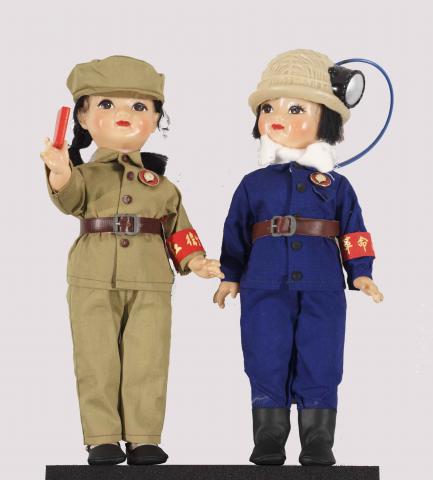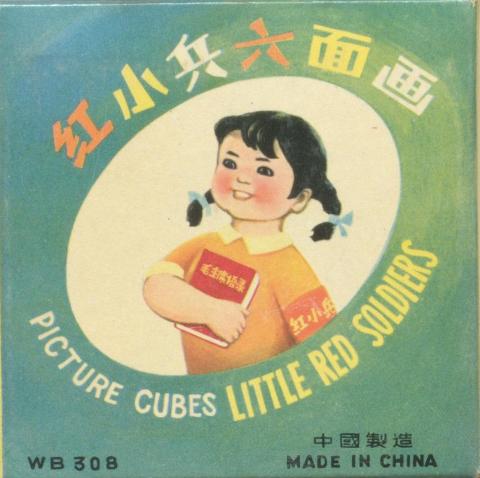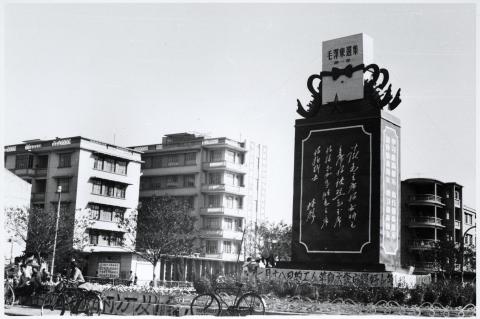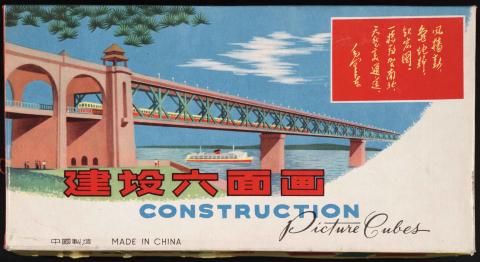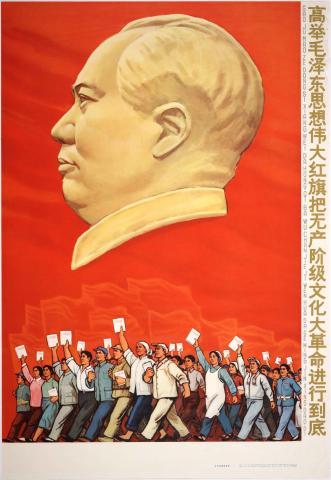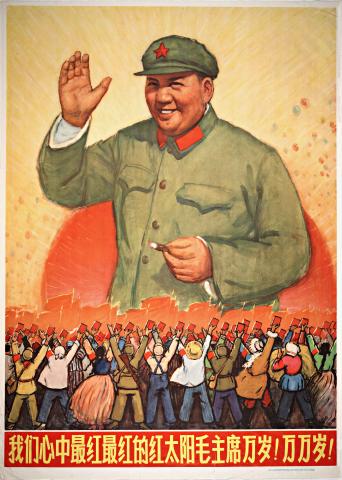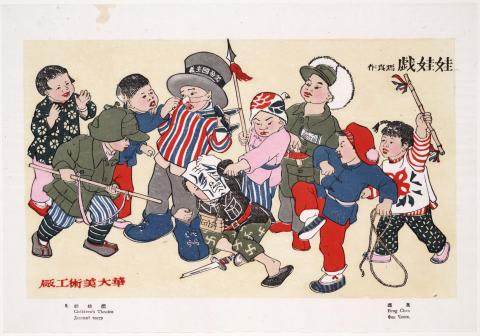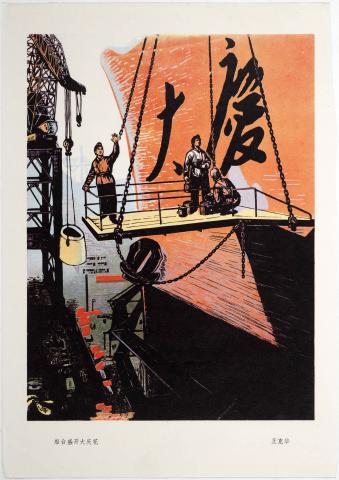Case one

2. Mao Zedong毛泽东 (1893-1976). Quotations from Chairman Mao Tse-tung [Zedong] (毛主席语录). Beijing: China People’s Liberation Army General Political Department, [June 1964].
3. Mao Zedong毛泽东 (1893-1976). Quotations from Chairman Mao Tse-tung [Zedong] (毛主席语录). Beijing: China People’s Liberation Army General Political Department, [August 1965].
4. Mao Zedong毛泽东 (1893-1976). Quotations from Chairman Mao Tse-tung [Zedong] (毛主席语录). Beijing: China People’s Liberation Army General Political Department, [?1964].
5. Mao Zedong毛泽东 (1893-1976). Quotations from Chairman Mao Tse-tung [Zedong] (毛主席语录). Beijing: China People’s Liberation Army General Political Department, 1966.
6. Mao Zedong毛泽东 (1893-1976). Quotations from Chairman Mao Tse-tung [Zedong] (毛主席语录), vest pocket edition. Beijing: China People’s Liberation Army General Political Department, 1967.
8. Mao Zedong (1893-1976). Quotations from Chairman Mao Tse-tung. Peking: Foreign Languages Press, 1966.
9. Badge in the shape of Quotations from Chairman Mao, Chinese edition. Ca. 1964-1970.
10. Badge in the shape of Quotations from Chairman Mao, English edition. Ca. 1966-1970.
9. Badge in the shape of Quotations from Chairman Mao, Chinese edition. Ca. 1964-1970.
10. Badge in the shape of Quotations from Chairman Mao, English edition. Ca. 1966-1970.
Case #2
19. All reactionaries are paper tigers. […]. Shanghai: Shanghai Revolutionary Education Publishing House, March 1968
20. Mark Gayn (1902-1981). Girls dance in a park before a poster pledging Chinese help to the Vietnamese in their struggle against ‘U.S. Imperialism.’ 1965.
21. Mark Gayn (1902-1981). Anti-American propaganda posters on display in a street in west China. These are now an integral part of the Chinese landscape. 1965.
22. Mark Gayn (1902-1981). An anti-American demonstration in Peking. 1965.
23. Mark Gayn (1902-1981). A hundred thousand people assemble in the Peking Stadium to protest ‘U.S. Aggression Against the Freedom Loving Dominican People.’ 1965.
24. Mark Gayn (1902-1981). No holiday passes without political playlets in the city parks, 3 photographs. 1965.
25. Suzanne Gayn (b. 1921). Playlet showing the Vietnamese chasing U.S. imperialists out of their country. 1967.
26. Suzanne Gayn (b. 1921). Dancing in Uniform. 1967.
27. The Chinese and Vietnamese People Shoulder-to-Shoulder – Selected Songs in Support of Vietnam Against the United States (中越人民肩并肩 – 援越抗美歌曲选). Guiyang: Guizhou People’s Press, 1965.
28. Selected Songs in Support of Vietnam Against the United States (援越抗美歌曲选). Guangzhou: Guangdong People’s Press, 1965.
29. The Chinese and Vietnamese People Fight Together (中越人民共同战斗 – 歌曲专辑). Shanghai: Shanghai Culture Press, 1965.
30. Zhang Leping张乐平 (1910-1992). Well Pressed: Some Thoughts on Visiting the 12,000 Ton Hydraulic Press (压得好: 参观一万二千吨水压机有感), 1965. [From Vietnam Must Win, the U.S. Must Lose (越南必胜 美国必败), collection 2. Shanghai: Shanghai People’s Fine Art Press, 1966].
31. Anqing Municipal Department of Cultural Affairs, United Amateur Print-Making Group (安庆市文化局联业余版画组). People around the World Mobilize and Rise Up to Annihilate U.S. Aggressors (全世界人民动员起来, 彻底消灭美国侵略者). From: Vietnam Must Win, the U.S. Must Lose (越南必胜 美国必败), collection 4. Shanghai: Shanghai People’s Fine Art Press, 1966.
32. Chen Changyuan陈昌源 (1938-1992). The Chinese People Firmly Support the Struggle of the Vietnamese People to Save their Nation from U.S. Aggression (中国人民坚决支援越南人民抗美救国斗争). From: Vietnam Must Win, the U.S. Must Lose (越南必胜 美国必败), collection 4. Shanghai: Shanghai People’s Fine Art Press, 1966.
33. Horizontal badge with text from Quotations from Chairman Mao, ‘Quotations from Chairman Mao: U.S. imperialism and reactionaries of all Nations are paper tigers’ (毛主席语录: 美帝国主义和各国反动派都是纸老虎). Ca. 1965
Case #3
34. The [In-] House Poster Group (本社宣傳画组). Long Live the Victory of the People’s War (人民战争胜利万岁). Shanghai: Shanghai People’s Fine Art Publishing House, November 1966.
35-36. Mao Zedong (1893-1976). Chairman Mao on People’s War. Beijing: Foreign Languages Press, 1967.
37. Lin Biao (1907-1971). Long Live the Victory of People’s War. Beijing: Foreign Languages Press, 1968.
38. Mao Zedong. Selected Military Writings of Mao Tse-tung. Beijing: Foreign Languages Press, 1966
39. Girl Gunner Doll, wind-up toy (女民兵, 动态玩具). Ca. 1967.
40. Don’t Love Red Dresses, Love Military Uniforms (不爱红装爱武装), postcard, after a painting of 1966. Ca. 1966-67.
41. Quotations from Chairman Mao: The Mass Line (毛主席语录: 群众路线). From Selected Papercuts after [Mao’s] Quotations (语录画刻纸选). Ca. 1968.
42. Badge with the text ‘Quotations from Chairman Mao: The Mass Line’ (毛主席语录:群众路线). Ca. 1968.
43. Warrior of Steel Armed with Chairman Mao Thought – Mai Xiande (毛主席思想武装的钢铁战士 -麦贤得). Beijing: People’s Liberation Army Pictorial Press, 1962.
44. Mark Gayn (1902-1981). Possibly as many as 100 million Chinese are enrolled in the militia, in which they receive military training. A scene in a Peking street. 1965.
Case #4
45. The Sunshine of Mao Zedong Thought Illuminates the Path of the Great Proletarian Cultural Revolution (毛泽东思想的阳光照亮无产阶级文化大革命的道路). Shanghai: Shanghai People’s Fine Art Publishing House, July 1967 (Fifth Printing).
46. The East is Red, The Helmsman Sets the Ocean Course, Long Live Chairman Mao – Songs and Music; and songbook (东方红, 大海航行靠舵手, 毛主席祝您晚虽无量-歌曲乐曲; 附歌本). Beijing: China Record Company, 1967.
47. The East is Red: Traditional Embroidery Design of Sun Rising over Waves Pin. Ca. 1966-1970.
48. The East is Red: Tiananmen Sunrise Gold Pin. Ca. 1966-1970.
49. The East is Red: Tiananmen Sunrise Red Enamel and Gold Pin. Ca. 1966-1970.
50. The East is Red: Tiananmen Sunrise Red Enamel and Gold Foliate Pin. Ca. 1966-1970.
51. The East is Red: Tiananmen Sunrise Red Enamel and Gold Polygonal Pin. Ca. 1966-1970.
52. ‘The East is Red’ (Dong fang hong): Tiananmen Sunrise Red and White Enamel and Gold Lozenge Pin. Ca. 1966-1970.
53. Chairman Mao is Our Great Red Sun: Mao Cameo Tiananmen Sunrise Red Enamel and Gold Shield-shaped Pin. Ca. 1966-1970.
54. ‘Long Live Invincible Mao Zedong Thought’ (Zhanwubusheng de Mao Zedong sixiang wansui): Mao Cameo in Red Sun above Red Banners Red Enamel and Gold Shield-shaped Pin. Ca. 1966-1970.
55. Envelope with an image of Yan’an for Wishing Chairman Mao a Boundless Long Life (敬祝毛主席万寿无疆), set of papercut portraits of Mao Zedong. Foshan, ca. 1967-68.
56. Envelope with an image of Tian’anmen for Wishing Chairman Mao a Boundless Long Life (敬祝毛主席万寿无疆), set of papercut portraits of Mao Zedong. Foshan, ca. 1967-68.
57. Papercut portrait of Chairman Mao: ‘Long Live Chairman Mao! Long, long live [Chairman Mao]!’ (‘毛主席万岁! 万万岁!’). Ca. 1967-68.
58. Papercut portrait of Chairman Mao, looking right. From Wishing Chairman Mao a Boundless Long Life (敬祝毛主席万寿无疆), Tian’anmen set. Foshan, ca. 1967-68.
59. Papercut portrait of Chairman Mao wearing a PLA uniform. From Wishing Chairman Mao a Boundless Long Life (敬祝毛主席万寿无疆), Tian’anmen set. Foshan, ca. 1967-68.
60. Chairman Mao Tse-tung is the Red Sun in the Hearts of the World’s Revolutionary People , English-language photographic folio. Beijing: Guozi shudian, ca. 1967-69.
61. Chairman Mao is the red sun in our hearts. From Chairman Mao Tse-tung is the Red Sun in the Hearts of the World’s Revolutionary People, English-language photographic folio. Beijing: Guozi shudian, ca. 1967-69.
62. Chairman Mao is like the sun; wherever it shines, it lights up the earth. […]. From Chairman Mao Tse-tung is the Red Sun in the Hearts of the World’s Revolutionary People, English-language photographic folio. Beijing: Guozi shudian, ca. 1967-69.
Case #5
63. Red Guards Congress of Colleges and Universities in the Capital, and the Red Painting Soldiers of the ‘The East Is Red Commune’ of the Beijing Film Academy (首都大专院校红代会, 北京电影学院东方红公社红画兵). Quotations from Chairman Mao […] ‘In Memory of Norman Bethune’ (毛主席语录[…]纪念白求恩). Beijing: People’s Fine Art Publishing House, February 1967.
64. ‘Bethune’ (Baiqiuen, 白求恩): BAIQIUEN, writing tablet. Ca. 1967.
65. Comrade Norman Bethune […]. From Selected Papercuts after [Mao’s] Quotations (语录画刻纸选). Ca. 1968.
66. Statue of Comrade Norman Bethune labelled ‘Bethune’ (Baiqiuen, 白求恩), Shiwan ware. Ca. 1967.
67. Study ‘In Memory of Norman Bethune’ (學習 《紀念白求恩》). Hong Kong: Hong Kong Commercial Press, 1966.
68. Horizontal badge with text from Quotations from Chairman Mao – In Memory of Norman Bethune, ‘Utter devotion to others without any thought of self.’ (毫不利己专门利人). Ca. 1965-68.
69-71. Assorted song cards with excerpts from ‘In Memory of Norman Bethune’ (纪念白求恩). From Quotations from Chairman Mao: A Selection of Songs of Chairman Mao (毛主席语录: 为毛主席语录谱曲歌选), Collection 2. Shanghai: Shanghai Number Three Paper Products Factory, ca. 1968.
72. Badge in the shape of ‘The Three Old Articles’ with ‘In Memory of Norman Bethune’ (纪念白求恩) on top. Ca. 1966-1976.
73. Badge in the shape of ‘In Memory of Norman Bethune’ (纪念白求恩). Ca. 1966-1976.
74. Badge in the shape of ‘Serve the People’ (为人民服务). Ca. 1966-1976.
75. Set of three badges of ‘The Three Old Articles:’ one with ‘Serve the People’ (为人民服务) on top; one with ‘In Memory of Norman Bethune’ (纪念白求恩) on top; one with ‘The Foolish Old Man who Removed the Mountains’ (愚公移山) on top. Ca. 1966-1976.
76. Mao Zedong (1893-1976). Serve the People; In Memory of Norman Bethune; The Foolish Old Man who Removed the Mountains. Peking: Foreign Languages Press, 1967.
77-80. Mao Zedong (1893-1976). Five Articles by Chairman Mao Tse-tung, vest pocket edition. Peking: Foreign Languages Press, 1968.
81-85. Assorted badges with text from ‘The Foolish Old Man who Removed the Mountains,’ ‘Be resolute, fear no sacrifice and surmount every difficulty to win victory.’ (下定决心, 不怕牺牲, 排除万难, 去争取胜利). Ca. 1965-68.
86. Song card with text from ‘The Foolish Old Man who Removed the Mountains,’ ‘Be resolute, fear no sacrifice and surmount every difficulty to win victory.’ From Quotations from Chairman Mao: A Selection of Songs of Chairman Mao (毛主席语录: 为毛主席语录谱曲歌选), Collection 2. Shanghai: Shanghai Number Three Paper Products Factory, ca. 1968.
87. Great teacher […] Long live Chairman Mao […] (伟大的导师 […] 毛主席万岁). From: A Vast World Where Much Can Be Accomplished: Celebrating the 23rd Anniversary of the Founding of the People’s Republic of China (广阔天地大有作为: 庆祝中华人民共和国成立二十三周年). Ca. 1972.
88. Revolutionary People Love Reading the ‘Old Three Articles’ – Songs about the Study of Chairman Mao’s Work (革命人愛讀 ‘老三篇’ —歌唱學習毛主席著作的歌曲). Beijing: China Record Company, 1967.
89. Long Live the ‘Three Old Articles’: Vocal Performance Material (老三篇"万岁: 演唱材料). Shanghai: Shanghai Cultural Press, 1966.
Case #6
90. Red Guards Congress of Colleges and Universities in the Capital, and the Red Painting Soldiers of the ‘The East Is Red Commune’ of the Beijing Film Academy (首都大专院校红代会, 北京电影学院东方红公社红画兵). Quotations from Chairman Mao Zedong: […] ‘Serving the People’ (毛主席语录: […]《为人民服务》 ). Beijing: People’s Fine Arts Publishing House, July 1967.
91. Portrait of Cai Yongxiang, papercut. Ca. 1968
92. Shandong Provincial Art School, Fine Art Division Collective (山东省艺术学校美术科集体). Complete Dedication to the Revolution: Chairman Mao’s Good Soldier – Wang Jie (一心為革命: 毛主席的好戰士 -王杰), set of sixteen images. Shanghai: Shanghai People’s Fine Arts Publishing House, January 1966.
93-97. Assorted song cards with excerpts from ‘Serving the People’ (为人民服务). From Quotations from Chairman Mao: A Selection of Songs of Chairman Mao (毛主席语录: 为毛主席语录谱曲歌选), Collection 2. Shanghai: Shanghai Number Three Paper Products Factory, ca. 1968.
98. Badge with photograph of Mao and Lin Biao and the text, ‘Serve the People’ (为人民服务). Ca. 1944-1950.
99-101. Assorted badges, gold lettering on red background, with the text, ‘Serve the People’ (为人民服务). Ca. 1964-1976.
102-104. Assorted badges (bilingual Chinese-English, English, French), gold lettering on white background, with Mao image in profile and the text, ‘Serve the People’ (为人民服务). Ca. 1966-1976.
105-107. Assorted badges, gold lettering on red or white background, with Mao cameo and the text, ‘Serve the People’ (为人民服务). Ca. 1966-1976
108. Chairman Mao’s Fighters are the Closest Followers of the Party (毛主席的战士最听党的話). Beijing: China Record Company, 1967.
Case #7
109. Jinggangshan Commune, Beijing Film Academy (北京电影学院, 井崗山公社). Mao Zedong: ‘The world is yours, as well as ours […]’ (毛泽东: ‘世界是你们的, 也是我们的 […]’). Beijing: People’s Fine Arts Publishing House, January 1967.
110. 语录画刻纸选). Ca. 1968.
111-118. Assorted dolls and action figures. Ca. 1966-1970.
119-120. Picture Cubes: Little Red Soldiers (红小兵六面画). Ca. 1966-1976.
121. Small Heroes of Vietnam (越南小英雄), picture cubes. Ca. 1965-1975.
122-124. Various badges with the text: ‘Study hard and every day you will improve’ (好好学习, 天天向上). Ca. 1966-1970.
125. Mark Gayn (1902-1981). Children in a kindergarten playing ‘bus.’ 1965.
126. Mark Gayn (1902-1981). An old man in charge of a portable library of comics for the kids […]. 1965.
127. Suzanne Gayn (b. 1921). Performing for foreign guests. 1967.
128. Suzanne Gayn (b. 1921). Students at the History Museum, Beijing. 1967.
129-130. All Red Hearts Are Turned to the Party: Suite of the Rural Young Pioneers (颗颗红心向着党: 农村少先队组歌); and songbook. Beijing: China Record Company, 1966.
131. Youngsters Love Chairman Mao: Children’s Voice [sic] in Unison (少年儿童热爱毛主席: 童声齐唱); and songbook. Beijing: China Record Company, 1967.
132. Reading for the Revolution (为革命读书). Compiled and illustrated by the ‘We are Chairman Mao’s Little Red Soldiers’ group, Zhabei district, [Shanghai] (闸北区 ‘我们是毛主席的红小兵’). Shanghai: Shanghai People’s Press, 1970.
133. Huang Ying 黄鶯 (b. ca. 1954). ‘We Are Successors to the Communist Cause’ (‘我们是共产主义接班人’), postcard, after a painting of 1966. Ca. 1966-67.
134. Wang Yuanxia 王緣霞 (b. ca. 1955) and Chen Lizhen 陳麗珍 (b. ca. 1952). Sunflowers Face the Sun (朵朵葵花向太陽), postcard, after an undated painting. Ca. 1966-67.
135. Wan Yuanyang 萬緣洋 (b. ca. 1955). Chairman Mao is the Red Sun of Our Hearts (毛主席是我們心中的紅太陽), postcard, after an undated painting. Ca. 1966-67.
Case #8
136. Zhou Ruizhuang周瑞庄 (1930- ). A Lifetime of Revolution, a Lifetime of Studying the Works of Chairman Mao (干一辈子革命, 读一辈子毛主席书). Shanghai: Shanghai People’s Fine Arts Publishing House, January 1966 (Seventh Printing).
137. Mao Zedong毛澤東 (1893-1976). Selected Works of Mao Zedong (毛澤東選集), 4 volumes. Beijing: People’s Publishing House, 1951-1960.
138. Mao Zedong (1893-1976). Selected Works of Mao Tse-tung, 4 volumes. Beijing: Foreign Languages Press, 1961-1965.
139. Suzanne Gayn (b. 1921). Monument to Mao’s Works. 1967.
140. Chairman Mao’s Works are a Treasure of Revolution – Songs in Praise of the Study of Chairman Mao’s Works (毛主席的书是革命的宝– 歌唱学习毛主席著作的歌曲). Beijing: China Record Company, [1967].
141-142. Red flag-shaped badges each with a gold Mao cameo and a gold, red, white image of a book with the text: ‘Selected Works of Chairman Mao’ (毛澤東選集), red and white enamel on gold metal. Ca. 1960-1970.
143. Badge in the shape of an open book; right page, red enamel with gold Mao cameo; left page, stamped gold metal with text: ‘Study Chairman Mao’s writings, follow his teachings, and act according to his instructions’ (读毛主席的书 听毛主席的话 做毛主席的指示办事), red and white enamel on gold metal. Ca. 1966-1970.
144. Mao Zedong毛泽东 (1893-1976). Poems of Chairman Mao (毛主席詩詞), string bound. Beijing: People’s Literature Press, 1974.
145. Mao Zedong毛泽东 (1893-1976). Poems of Chairman Mao (毛主席詩詞). Beijing: Cultural Relics Publishing House, 1966.
146. Mao Zedong (1893-1976). Mao Tsetung: Poems. Beijing: Foreign Languages Press, 1976.
147. Mao Zedong毛泽东 (1893-1976). The Double Ninth (采桑子·重阳), calligraphy, 1929; reproduction. Beijing: Cultural Relics Press, ca. 1968.
148. Drinking glass with Mao’s calligraphy of The Double Ninth (采桑子·重阳). Ca. 1966-1976.
149. Box lid, Construction Picture Cubes (建设六面画); with an excerpt of Mao’s calligraphy for his poem ‘Swimming – to the tune of Shui Tiao Keh Tou [shui diao ge tou]’ (水调歌头·游泳). Ca. 1969.
South Mezzanine
150. Liu Hulan Commune of the Beijing Film Academy and Jinggangshan Commune of the Prairie Fire Rebel Corps (北京电影学院刘胡兰公社, 燎原造反兵团井崗 山 公社作). Mao Zedong: ‘The force at the core leading our cause forward is the Chinese Communist Party. The theoretical basis guiding our thinking is Marxism-Leninism.’ (毛泽东: 领导我们事业的核心力量是中国共产党. 指导我们思想的理论基础是马克思列宁主义.) Beijing: People’s Fine Arts Publishing House, March 1967.
151. The [In-] House Poster Group (本社宣傳画组). Raise High the Great Red Flag of Mao Zedong Thought to Carry Out to the End the Great Proletarian Cultural Revolution (高举毛泽东思想伟大红旗把无产阶级文化大革命进行到底). Shanghai: Shanghai People’s Fine Art Publishing House, July 1967, 5th printing.
152. Long Live Chairman Mao, the Reddest, Reddest Red Sun in Our Hearts! Long Long Live [Chairman Mao] (我们心中最红最红的红太阳毛主席万岁! 万万岁!). Shanghai: Shanghai People’s Fine Arts Publishing House, July 1967, 2nd printing.
MacLean Hunter Room
153. Mark Gayn and Liu Shaoqi. 1947.
154. Xin Mang 辛莽 (b. 1916). Chairman Mao Writing at Yan’an (毛主席在延安著作). Shanghai: People’s Fine Art Publishing House, May 1964 (Third Printing).
155. Silk tapestry envelope, decorated with a reproduction of an ink painting of Chairman Mao writing ‘Bombard the Headquarters’ (炮打司令部). Hangzhou ‘The East is Red’ Silk Fabric Factory (中国杭州 ‘东方红’ 丝织厂), ca. 1967-1971.
156. Chairman Mao, greatest proletarian revolutionary, our most respected and beloved leader. From Chairman Mao Tse-tung is the Red Sun in the Hearts of the World’s Revolutionary People, English-language photographic folio. Beijing: Guozi shudian, ca. 1967-69
157. Mao Zedong毛澤東 (1893-1976). Reply to Comrade Kuo Mo-jo [Guo Moruo] – to the tune of Man Chiang Hung [Manjiang hong] (满江红·和郭沫若同志), flocking-printed calligraphy facsimile. Ca. 1966-1976.
158-165. Assorted Early Badges with Mao Photos and Various Slogans, ca. 1940s.
166. Made entirely in-house. (全自力作). Daily Study, Daily Application (天天学, 天天用). Shanghai: Shanghai People’s Fine Art Press, April 1966.
167. Pang Ka 龐卡 (b. 1935). Advance Courageously Under the Guidance of the Red Flag of Mao Zedong Thought (在毛泽东思想红旗指引下, 奋勇前进). Shanghai: Shanghai People’s Fine Art Press, January 1966 (Fourth Printing).
168. You Longgu游龙姑 (1923-1993). Study Mao Zedong Thought, Be the Successors of Communism. (学习马泽东思想, 做共产主义接班人). Shanghai: Shanghai People’s Fine Art Press, February 1965 (Fifth Printing).
169. Zang Erkang臧尔康 (b. 1936). Study for the Revolution; Truly Take Mao Zedong Thought in Hand (为革命而学, 把毛泽东思想真正学到手). Shenyang: Liaoning Fine Art Publishing House, August 1965.
170. Ha Qiongwen 哈琼文 (1925-). Intellectuals Turn to Labour: An Exercise in Practical Struggle Rooted in the Masses of Workers and Peasants (知识分子劳动化: 在实际斗争中锻炼, 在工农群众中扎根). Shanghai: Shanghai People’s Fine Art Press, February 1965 (Second Printing).
171. Unknown Photographer. Mark and Suzanne Gayn in Israel. 1971.
172. Peng Shaomin 彭召民 (b. 1935). Collective Red Hearts, Like-Minded Join Forces for a Bumper Crop (颗颗红心为集体, 齐心合力夺丰收). Beijing: People’s Fine Art Press, July 1965 (Second Printing).
173. The [In-] House New Year’s Picture Creative Group (本社年画创作组). Study the ‘Three Old Articles’ Forever (永远学习 ‘老三篇’). Shanghai: Shanghai People’s Fine Art Press, July 1967 (Third Printing).
174. Zhou Ruizhuang周瑞庄 (1930- ). The Intellectualization of the Working People: Be a New Type of Worker, Lettered and Militarized (劳动人民知识化: 做一个能文能武的新型劳动者). Shanghai: Shanghai People’s Fine Art Press, February 1965 (Second Printing).
175. Mark Gayn (1902-1981). Exhortation to workers to read Mao Tse-tung’s books in a Shanghai factory yard. 1965.
176. Xie Guangnian 謝广年 (fl. 1960s). Study the Unyielding Proletarian Spirit of Comrade Mai Xiande. (学习麦贤得同志的无产阶级硬骨头精神). Shanghai: Shanghai People’s Fine Art Press, March 1966 (First Printing).
177. Drafted by the Political Department of the Zhejiang Military District (浙江軍区政治部供稿). A Communist Fighter Thoroughly Devoted to the Public – Cai Yongxiang (一心为公的共产主义战士 – 蔡永祥). Beijing: People’s Fine Art Press, April 1967 (First Printing).
178. Drafted by the PLA Pictorial (街坊軍画报供稿). Chairman Mao’s Good Soldier, Lü Xiangbi (毛主席好战士吕祥璧). Beijing: People’s Fine Art Press, 1967 (First Printing).
179. Mark Gayn (1902-1981). The offices of the People's Daily, the official organ of the Communist Party. It is ‘must’ reading for every Communist and every official who wants to get ahead. 1965
180. Mark Gayn (1902-1981). Every city has its displays of propaganda cartoons and photographs. This is a typical one. 1965
181. Suzanne Gayn (b. 1921). Women reading, among other things, poems by women. Guangzhou, 1967.
182. Suzanne Gayn (b. 1921). Public posting and reading of a telegram from Beijing. Guangzhou, 1967.
183. Feng Zhen冯真(b. 1931). Children’s Theatre (娃娃戲), 1948. From Selected Works of New Year’s Prints, edited by China National Art Workers’ Association. Beijing: Rongbaozhai xinji, 1950.
184. Hong Bo 洪波 (1923-1985). Enlisting in the Army (參軍圖). Zhengding, Hebei: Fine Art Factory of Northern China United University.
185. Hong Bo 洪波 (1923-1985). Enlisting in the Army (參軍圖). From Selected Works of New Year’s Prints, edited by China National Art Workers’ Association. Beijing: Rongbaozhai xinji, 1950.
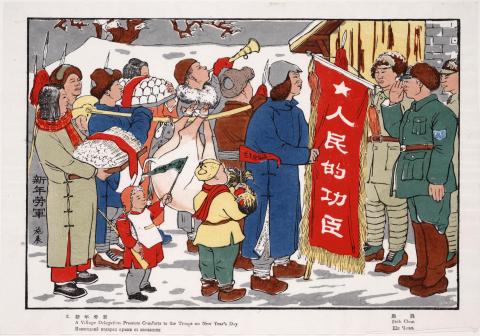
186. Shi Zhan施展 (1912-1993). A Village Delegation Presents Comforts to the Troops on New Year’s Day (新年勞軍), 1947. From Selected Works of New Year’s Prints, edited by China National Art Workers’ Association. Beijing: Rongbaozhai xinji, 1950
187. Yan Han彦涵 (1916-2011). Launching the Guerilla Landmine Campaign (开展民兵爆炸运动). Zhengding, Hebei: Fine Art Factory of Northern China United University.
188. Yan Han彦涵 (1916-2011). Launching the Guerilla Landmine Campaign (开展民兵爆炸运动). From Selected Works of New Year’s Prints, edited by China National Art Workers’ Association. Beijing: Rongbaozhai xinji, 1950.
189-190. [Giorgio Liberale]. Cichorium hortense [art original]. Woodblock [ca. 1562] and modern woodblock print.
191. Xu Tongchao徐通潮 (fl. ca. 1960s) and Chen Yongzhen陈永镇 (b. 1936). A Story of the Vietnamese People’s Struggle Against the U.S: Finding the Guerillas (越南人民反美斗争故事: 找游击队去). Shanghai: Shanghai People’s Press, November 1965 (First Edition); February 1972 (Third Printing).
192. Hu Yanfeng呼延风 (fl. ca. 1960s). A Story of the Vietnamese People’s Struggle Against Imperialism: Two Small Sentries (越南人民反帝斗争故事: 两个小哨兵). Beijing: China Children’s Press, November 1965.
193. Zhang Bangji张邦辑 (b. 1937). Fighting Village (战斗村); lithographic reproduction. From Vietnam Must Win, the U.S. Must Lose (越南必胜 美国必败), collection 4. Shanghai: Shanghai People’s Fine Art Press, February 1966.
195. Yang Yongqing杨永青 (1928-2011). A Story of the Vietnamese People’s Struggle Against Imperialism: The Wonderful Trap (越南人民反帝斗争故事: 奇妙的陷阱). Beijing: China Children’s Press, June 1965.
196. Liang Ping梁平 (fl. ca. 1960s). Little Soldiers (小小兵). Beijing: China Children’s Press, September 1965 (First Edition); October 1978 (Third Printing).
197. Ge Fei 戈非 (fl. 1940s-1980s). Walk Towards the Sun (走向太阳). Beijing: China Children’s Press, March 1966.
198. A Gun-Selling Barge (一支驳卖枪). Shanghai: Shanghai People’s Fine Art Press, June 1964.
199. Opera program for Revolutionary Modern Beijing Opera: The Taking of Tiger Mountain (革命现代京剧: 智取威虎山). October 1969.
200. Opera program for Revolutionary Modern Beijing Opera: Red Light Story (革命现代京剧: 红灯记). May 1970.
201-206. Bookmarks with Quotations from The Diary of Lei Feng. Publication information unknown.
207. Musical Settings for the Poems of Chairman Mao (为毛主席诗词谱曲, 歌曲). Beijing: China Record Company, ca. 1967-1976.
208-209. Selections from Revolutionary Songs, sides 1-2; and songbook (革命歌曲选, 第一集; 附歌本). Beijing: China Record Company, 1965.
210. Wu Qiangnian吴强年 (b. 1937). The People of South Vietnam Must Win the Fight against U. S. Imperialism! (越南南方人民的反美斗争必胜!) Beijing: People’s Fine Art Publishing House, May 1965 (Second Printing).
211. Wang Kehua (王克华). The Flowers of Daqing Blooming in a Shipyard (船台盛开大庆花); lithographic reproduction. From The Flowers of Daqing Blooming in a Shipyard. Shanghai: Shanghai People’s Press, 1975.
212. Wei Zhenbao魏振保 (b. 1944). After Class (课后); lithographic reproduction. From The Flowers of Daqing Blooming in a Shipyard. Shanghai: Shanghai People’s Press, 1975.
213. Take Charge of the Revolution, Promote Production, Promote Work, Promote Combat Readiness (抓革命, 促生产, 促工作, 粗战备); lithograph. From A Vast World Where Much Can Be Accomplished: Celebrating the 23rd Anniversary of the Founding of the People’s Republic of China (广阔天地大有作为: 庆祝中华人民共和国成立二十三周年). October 1972.
214. ‘The East is Red’ Revolutionary Headquarters of the Fudan University Red Guards, Shanghai (上海复旦大学红卫兵 ‘东方红’ 造反总部). Seven Hundred Million People [Equals] Seven Hundred Million Soldiers (七亿人民七亿兵), 1969; lithograph. From A Vast World Where Much Can Be Accomplished: Celebrating the 23rd Anniversary of the Founding of the People’s Republic of China. October 1972.
215. A Vast World Where Much Can Be Accomplished (广阔天地大有作为); lithograph. From A Vast World Where Much Can Be Accomplished: Celebrating the 23rd Anniversary of the Founding of the People’s Republic of China. October 1972.
216. A Vast World Of Linked Red Hearts (广阔天地练红心), 1968; lithograph. From A Vast World Where Much Can Be Accomplished: Celebrating the 23rd Anniversary of the Founding of the People’s Republic of China (广阔天地大有作为: 庆祝中华人民共和国成立二十三周年). October 1972.
217. A Land of Splendours (錦繡河山). No publication data.














